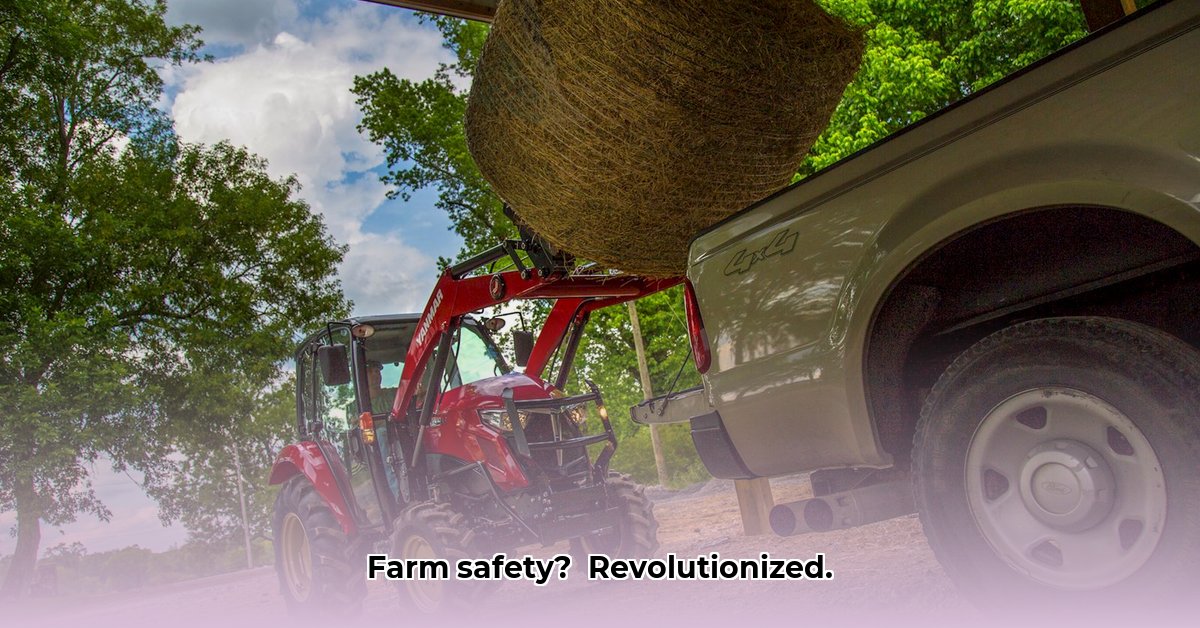
Farming is demanding work, and the challenges are intensifying. An aging farming population, coupled with the inherent physical demands of the profession, creates a significant safety concern. This article explores how assistive tractor technology—specifically lift tractor solutions—is revolutionizing agricultural safety and accessibility, creating a more sustainable and productive future for farmers of all ages and abilities. For more information on farm safety, check out this helpful resource.
Addressing the Aging Farmer Crisis: A Technological Solution
The average age of American farmers is climbing, leading to increased risk of injury from operating heavy machinery. This isn't just about comfort; it’s about safeguarding the health and well-being of experienced farmers, ensuring the continuation of agricultural expertise. Lift tractors address this directly by making the process of entering and exiting tractors significantly easier and safer. But these innovations are more than mere conveniences; they are critical tools for the future of agriculture, improving efficiency and longevity for farmers.
Beyond the Lift: Customizable Comfort and Cost-Effectiveness
Several companies are developing highly customizable lift systems, like the CoachLift, offering tailored solutions for individual needs and physical limitations. However, this level of personalization often translates to a high cost, creating a barrier to entry for many smaller farms. "The affordability issue poses a significant challenge," notes Dr. Emily Carter, Agricultural Engineer at Purdue University. "Finding a balance between personalized comfort and accessible pricing is paramount to widespread adoption." This requires innovative solutions, such as modular designs, to reduce production costs and allow farmers to select only the features they require. This modular approach could revolutionize accessibility, making these systems viable for a wider spectrum of farmers.
Sustainability: A Holistic Approach to Farming's Future
The sustainability of lift tractor technology extends beyond immediate function and encompasses the entire life cycle of the machine. "Claims about 'Made in the USA' manufacturing need careful scrutiny," warns Dr. Ben Miller, Professor of Sustainable Agriculture at the University of California, Davis. “We must examine the environmental impact of every component, from material sourcing to manufacturing processes and eventual disposal.” This includes incorporating sustainable materials, minimizing waste, and reducing the machine's carbon footprint through efficient design and manufacturing practices. A truly sustainable lift tractor solution must prioritize environmental responsibility from conception to decommissioning.
Collaborative Innovation: A Shared Responsibility for Safer Farming
Creating safer and more accessible farming practices requires a collaborative approach. Tractor and lift manufacturers must actively engage with farmers to understand their specific needs. Government agencies play a crucial role, potentially incentivizing adoption through grants, tax breaks, or subsidies. "This isn't just about individual farmers; it's about strengthening our entire food system," emphasizes Sarah Jones, Policy Advisor at the USDA. This shared commitment—a collaborative effort between manufacturers, farmers, and policymakers—is vital for building a brighter, safer future for agriculture.
A Roadmap to Wider Adoption: Actionable Steps for All Stakeholders
Effective implementation requires a concerted effort from all stakeholders. The data below outlines short-term and long-term actions:
| Stakeholder | Short-Term Actions | Long-Term Actions |
|---|---|---|
| Farmers | Research available options; explore funding opportunities. | Provide manufacturer feedback; advocate for inclusive policies within their communities. |
| Tractor Manufacturers | Conduct market research; prioritize accessibility features in designs. | Develop standardized, modular lift systems; collaborate with lift manufacturers for integrated solutions. |
| Government Agencies | Fund research; promote best practices in ergonomics and workplace safety. | Implement financial incentives; update safety regulations to prioritize accessibility for all farmers. |
| Lift Manufacturers | Streamline manufacturing; improve marketing and outreach. | Develop compatible models for various tractor brands; explore OEM partnerships for expanded reach. |
How can we ensure widespread adoption of these potentially life-changing technologies? The answer lies in a multifaceted approach.
Choosing Sustainable and Affordable Tractor Access Lifts: A Practical Guide
The critical need for improved access to tractors for aging farmers is undeniable. But how do we choose the right solution in terms of cost and sustainability?
Assessing Individual Needs and Budgets
Before any investment, a thorough needs assessment is critical. This involves determining the farmer's physical limitations, tractor type, and available budget. Simple additions, like enhanced steps and handrails, can significantly improve safety for some. Others may require more complex, automated lift systems. A well-informed decision is key to maximizing effectiveness and minimizing risks.
Types of Tractor Access Lifts: A Spectrum of Solutions
Several lift types exist, ranging from simple upgrades like improved steps and handrails to more advanced hydraulic or electric lifts. Each option offers varying levels of assistance and cost. It's essential to consider factors such as longevity, ease of maintenance, and compatibility with the existing tractor infrastructure. Sustainability demands a focus on durability and minimal environmental impact throughout the product's lifecycle.
Balancing Sustainability and Affordability
Sustainability isn't solely about environmental impact; it also includes the long-term financial viability of the chosen lift. A durable system minimizes replacement needs and long-term costs. Using locally sourced materials or repurposing existing components can further reduce both costs and the environmental footprint. Accessing available grants or assistance programs can also make these essential safety upgrades more financially accessible.
Safety as the Non-Negotiable Priority
Regardless of the chosen system, safety must be paramount. Proper installation, thorough testing, and regular inspections are essential for preventing accidents. Emphasizing three-point contact during entry and exit further minimizes the fall risk. Comprehensive training for the farmer is crucial to ensuring safe and effective use of the lift.
A Holistic Accessibility Strategy: Looking Beyond the Lift Alone
A lift is only one component in building a fully accessible farming operation. Ergonomic cab modifications, like adjustable seats and controls, can further enhance the farming experience. Farmers should also consider collaborating with agricultural extension services or occupational therapists for personalized guidance and tailored solutions, further optimizing safety and productivity. [1] provides further resources on agricultural equipment access and modifications.
The future of farming is brighter with the implementation of lift tractor technologies. A collaborative effort between all stakeholders ensures a safe, accessible, and sustainable future for all involved.